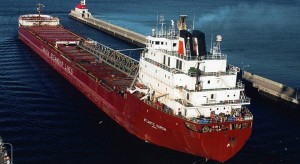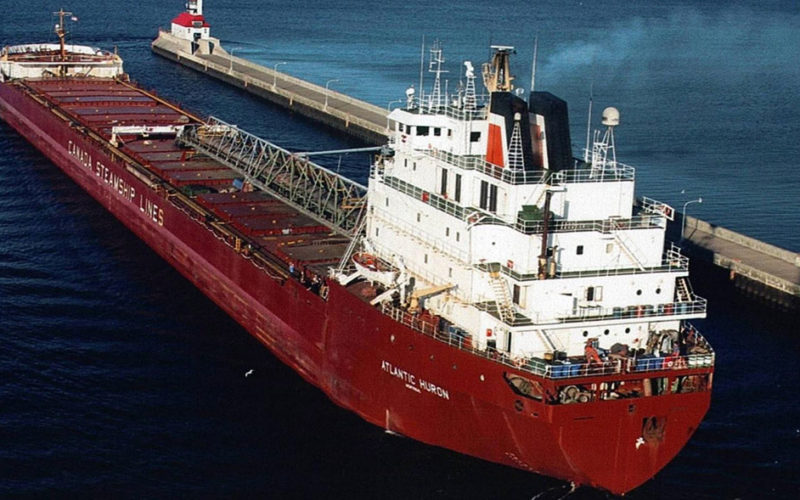
The Great Lakes freighter Atlantic Huron was downbound in the St. Mary’s River when its captain began slowing for the approach into the Soo Locks. Instead, the vessel unexpectedly gained speed.
The captain’s attempts to regain control or stop the ship before the locks were not successful. The 736-foot self-unloading bulker hit the south side of the Soo Locks’ west center pier at nearly 7 knots at 0250 on July 5, 2020. The ship stopped well short of the lock gates.
The impact caused $1.6 million in damage to the ship’s forward portside hull. The lock pier required $573,000 in repairs. None of the 25 crew members reported injuries.
“The probable cause of the contact between the Atlantic Huron and the west center pier at Soo Locks was not following the manufacturer’s requirement to use thread-locking fluid during installation of the feedback ring locking pin set screw on the vessel’s controllable pitch propeller system,” the National Transportation Safety Board (NTSB) said in its accident report.
“As a result, the set screw was able to back out, beginning a sequence of mechanical failures that resulted in the ship moving ahead when it was supposed to be doing the opposite, while still indicating an astern pitch on the ship’s bridge,” the agency said in a news release summarizing the report.
The Canada-flagged Atlantic Huron is powered by a single diesel engine paired with a controllable pitch propeller (CPP) that can propel the ship ahead or astern without changing the shaft direction. The ship was in ballast as it approached the Soo Locks headed for Meldrum Bay, Ontario, in Lake Huron. The captain slowed to 3.8 knots at 0245, when the ship was a half-mile from the western end of the west center pier.
The captain ordered full astern but noticed the CPP indicator on the bridge was “erratic” — fluctuating from full ahead to full astern to zero. A wrong-way alarm indicated the requested propeller pitch did not match the actual pitch, the report said.
The captain called the engine control room. The engineer on watch reported no such alarms, and that the pitch indicator showed full astern. Moments later, the captain noticed the vessel was accelerating even as the bridge pitch indicator showed full astern.
The chief engineer and watch engineer went to inspect the controllable pitch propeller control valve assembly in the lower engine room. They intended to verify the pitch and alter the pitch manually if needed. The assembly is mounted atop the oil distribution (OD) box, a critical part of the CPP hydraulic system.
“Normally, the OD box sat on the shaft with bearings, and a ‘torque stay,’ or locking pin, prevented the box from rotating. The chief engineer discovered that the OD box assembly had rotated on the drive shaft and was no longer retained by the torque stay,” investigators said.
Meanwhile, Atlantic Huron continued to gain speed, reaching 6.5 knots when the captain sounded the general alarm and ordered crew to drop the stern anchor. About 600 feet from the pier, the vessel’s speed increased to 7.1 knots. The captain dropped two bow anchors remotely from the bridge.
Around this time, the chief engineer called the captain for approval to shut down the main engine. At 0250 the Atlantic Huron’s port bow struck the pier at 6.8 knots, slowing as it slid alongside the pier.
A post-accident inspection of the OD box discovered “severe damage” to the unit’s valve assembly, including the feedback arm, the report said. The technician also found the pin holding the feedback ring in place and the set screw holding the pin in place had both backed out.
“Inspection of the set screw by the technician revealed that it was ‘not damaged’ and that there was ‘no evidence’ of thread-locking fluid having been applied,” investigators said.
Maintenance records showed the feedback ring pin set screw had been removed and reinstalled in 2016 for maintenance to the tail shaft.
CSL Group Inc., which owns the vessel, told investigators the way “the OD box and control valve assembly failed would have caused hydraulic fluid to be inadvertently directed, producing a full ahead pitch on the propeller blades when an astern pitch was ordered,” according to the report.
Investigators learned the OD box had been repaired a few days earlier following a similar incident when the vessel tried to slow in open water. But the problem was determined to be a worn torque stay that was replaced. A class surveyor who inspected the repair deemed it acceptable in the short term.
The previous incident was likely caused by the same type of mechanical failure. But because the repairs solved the problem without having to disassemble the OD box, investigators considered it understandable that the underlying problem was not identified.
The NTSB determined the captain could have stopped the main engine once he noticed the erratic pitch indicator and the vessel increase speed. However, they acknowledged he had a short time to act during a period of stress and confusion about the propulsion problem.
“Loss of propulsion control in a critical phase of operation demands crewmembers act quickly to mitigate potential accidents,” the report said. “Part of a safety management system should address potential emergency shipboard situations, including loss of propulsion, collision, and contact, and establish ways to respond to them.”
Following the accident, the CSL Group said it was reviewing its safety management system to develop ship-specific contingency plans for emergencies.
The CSL Group, parent company of Canada Steamship Lines, did not respond to a request for comment.

